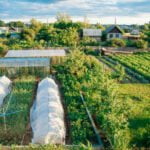Arizona may be known for its desert landscape, but that doesn’t mean you can’t enjoy a bountiful harvest of fruits and vegetables right in your own backyard. Fruit and vegetable gardening in Arizona comes with its own set of challenges and rewards, making it an exciting venture for gardeners looking to explore the unique possibilities this state has to offer.
With its sunny days and warm temperatures, Arizona provides an ideal environment for growing a variety of fruits and vegetables. From citrus trees to leafy greens, there are endless possibilities for what you can cultivate in your Arizona garden. By understanding the nuances of Arizona’s climate and soil, you can create a thriving garden filled with fresh, homegrown produce.
In this article, we will delve into the world of fruit and vegetable gardening in Arizona, exploring the best fruits and vegetables to grow in this climate, offering tips for success, and providing resources to help you on your gardening journey. Whether you’re a seasoned gardener or just starting out, there’s something special about tending to your own fruits and vegetables in the unique setting of Arizona.
Best Fruits to Grow in Arizona’s Climate
Arizona’s climate can pose some challenges for fruit and vegetable gardening, but with the right knowledge and techniques, you can still enjoy a bountiful harvest. When it comes to choosing the best fruits to grow in Arizona, it is important to consider the region’s hot and arid conditions. One of the top fruits that thrive in Arizona’s climate is citrus. Varieties such as oranges, lemons, and grapefruits do exceptionally well in the warm weather.
Another excellent fruit to grow in Arizona is figs. These sweet and nutritious fruits are well-suited for the state’s climate, requiring minimal care once established. Additionally, pomegranates are a great choice for Arizona gardeners looking to add some color and flavor to their harvest. Pomegranate trees are drought-tolerant and produce vibrant red fruits that are not only delicious but also packed with antioxidants.
One more fruit that deserves a spot in your Arizona garden is dates. Date palms are known for their ability to withstand high temperatures and low humidity levels, making them an ideal choice for desert landscapes. With proper care and attention to watering needs, you can enjoy fresh dates straight from your own backyard. By incorporating these fruits into your garden, you can create a diverse and fruitful landscape that thrives in Arizona’s unique growing conditions.
| Fruit | Benefits |
|---|---|
| Citrus | Rich in Vitamin C |
| Figs | Sweet and nutritious |
| Pomegranates | High in antioxidants |
| Dates | Drought-tolerant and flavorful |
Best Vegetables to Grow in Arizona’s Soil
Arizona’s diverse climate and soil conditions provide a unique opportunity for fruit and vegetable gardening enthusiasts to grow a variety of crops throughout the year. When it comes to selecting vegetables that thrive in Arizona’s soil, there are several options that stand out due to their adaptability and resilience.
One of the best vegetables to grow in Arizona’s soil is tomatoes. With proper care and attention, tomatoes can flourish in the warm Arizona climate. Varieties such as Roma, cherry, and beefsteak tomatoes are known to do well in the state’s conditions. Planting tomatoes in well-draining soil with plenty of sunlight can lead to a bountiful harvest.
Another excellent vegetable choice for Arizona gardeners is bell peppers. Bell peppers not only add vibrant color to your garden but also offer a range of culinary uses. Whether you prefer green, red, or yellow varieties, bell peppers require full sun exposure and fertile, well-drained soil to prosper. By providing sufficient water and nutrients, you can enjoy an abundant supply of crisp bell peppers straight from your garden.
In addition to tomatoes and bell peppers, leafy greens like lettuce and spinach also thrive in Arizona’s soil. Planting these vegetables in early spring or late summer can help avoid the scorching heat of the summer months. Lettuce and spinach appreciate light shade during the hottest parts of the day and regular watering to maintain moisture levels in the soil. By incorporating these versatile vegetables into your garden, you can savor fresh salads all season long.
| Best Vegetables for Arizona Soil | Tips for Success |
|---|---|
| Tomatoes | Plant in well-draining soil with plenty of sunlight. |
| Bell Peppers | Require full sun exposure and fertile, well-drained soil. |
| Lettuce & Spinach | Plant in early spring or late summer with light shade during hot parts of the day. |
Tips for Successful Fruit and Vegetable Gardening in Arizona
Arizona’s unique climate presents both challenges and opportunities for fruit and vegetable gardening enthusiasts. With scorching hot summers and mild winters, it is important to adapt your gardening techniques to maximize success in this arid environment. Here are some tips for successful fruit and vegetable gardening in Arizona:
Watering Techniques
One of the key factors to consider when growing fruits and vegetables in Arizona is water management. The intense heat can quickly dry out the soil, so it is crucial to establish a regular watering routine. Drip irrigation systems are a popular choice for Arizona gardeners as they deliver water directly to the roots, minimizing evaporation. Mulching around plants can also help retain moisture in the soil.
Soil Preparation
Arizona’s soil tends to be alkaline and low in organic matter, making it challenging for certain plants to thrive. To improve soil quality, consider adding compost or well-aged manure before planting. This will provide essential nutrients for your fruits and vegetables and help with moisture retention.
Shade and Sun Protection
Given Arizona’s intense sun exposure, providing shade for delicate plants is essential. Consider planting taller crops like corn or sunflowers on the western side of your garden to provide shade for smaller plants during the hottest part of the day. Additionally, using shade cloth or row covers can protect sensitive plants from sunburn during the peak summer months.
By implementing these tips and adjusting your gardening practices to suit Arizona’s unique climate, you can enjoy a bountiful harvest of fresh fruits and vegetables year-round in your own backyard oasis.
Dealing With Arizona’s Unique Weather Challenges in Gardening
Arizona’s unique weather challenges can present obstacles for fruit and vegetable gardening, but with the right strategies, gardeners can still achieve success in cultivating their own produce. Understanding the climate and adapting gardening practices accordingly is crucial for a thriving garden in Arizona.
To tackle the intense heat and arid conditions in Arizona, here are some tips to help gardeners navigate these weather challenges:
- Implement drip irrigation systems or soaker hoses to ensure efficient water delivery directly to plant roots.
- Use mulch around plants to retain soil moisture, reduce evaporation, and protect roots from extreme temperatures.
- Consider providing shade structures or planting companion plants that can offer protection from the scorching sun.
Furthermore, timing is key when it comes to planting fruits and vegetables in Arizona. Choosing varieties that can withstand the heat and following planting schedules suited for the region can greatly increase the chances of a successful harvest. By being mindful of the weather patterns and making adjustments as needed, gardeners can overcome Arizona’s weather challenges and enjoy a bountiful harvest of homegrown produce.
How to Choose the Right Fruit Trees for Your Arizona Garden
When it comes to fruit and vegetable gardening in Arizona, choosing the right fruit trees for your garden is essential for a successful harvest. The arid climate and intense heat in Arizona can pose challenges, but selecting the appropriate fruit trees can help you overcome these obstacles and thrive. Here are some tips on how to choose the right fruit trees for your Arizona garden.
Consider Climate Adaptability
One of the key factors to consider when choosing fruit trees for your Arizona garden is their adaptability to the local climate. Look for fruit tree varieties that are drought-tolerant and can withstand high temperatures. Some fruits that thrive in Arizona’s climate include citrus fruits like oranges, lemons, and grapefruits, as well as figs, pomegranates, and dates. These fruits are well-suited for the hot and dry conditions in Arizona.
Choose Dwarf or Semi-Dwarf Varieties
In Arizona, space can be limited in your garden due to constraints such as water availability and soil conditions. Opting for dwarf or semi-dwarf fruit tree varieties can help you maximize your space while still enjoying a bountiful harvest. These smaller-sized trees are also easier to maintain and harvest, making them ideal for home gardeners.
Consider Pollination Requirements
When selecting fruit trees for your Arizona garden, it is important to consider their pollination requirements. Some fruit tree varieties require cross-pollination with another compatible tree to produce fruits successfully. Be sure to check the pollination requirements of the fruit trees you choose and plant them accordingly to ensure a productive harvest. Additionally, planting bee-friendly flowers nearby can attract pollinators and help increase your fruit tree’s yield.
Companion Planting in Arizona for Maximum Yield
Companion planting is an essential practice for maximizing yields and promoting healthy growth in fruit and vegetable gardening in Arizona. By strategically pairing certain plants together, you can create a harmonious ecosystem that not only deters pests but also supports pollination and nutrient absorption. Here are some examples of effective companion planting combinations to consider for your Arizona garden:
- Tomatoes and basil: Planting basil near your tomato plants can help repel pests like aphids, while also enhancing the flavor of your tomatoes.
- Marigolds and vegetables: Marigolds are known for their pest-repelling properties, making them great companions for a variety of vegetables such as tomatoes, peppers, and squash.
- Cucumbers and dill: Dill attracts beneficial insects that prey on cucumber beetles, which can be detrimental to cucumber plants. Plus, the fragrance of dill can help mask the scent of cucumbers from pests.
Furthermore, incorporating pollinator-attracting flowers like bee balm or sunflowers into your garden can help ensure proper pollination for your fruit trees, leading to larger yields. Additionally, interplanting nitrogen-fixing legumes such as peas or beans with heavy feeders like corn or squash can provide a natural source of fertilizer for your crops.
In Arizona’s arid climate, companion planting becomes even more crucial as it can help conserve water by creating shade, retaining moisture in the soil, and reducing the need for chemical pesticides. By implementing these strategic pairings in your fruit and vegetable garden, you can create a thriving ecosystem that promotes plant health and overall productivity.
Resources for Fruit and Vegetable Gardening in Arizona
Arizona’s unique climate and soil conditions can pose challenges for fruit and vegetable gardening, but with the right resources, gardeners can still enjoy a bountiful harvest. One important resource for successful gardening in Arizona is choosing the right plants that are well-suited to the region’s hot and arid climate. Local nursery staff and agricultural extension offices can provide valuable guidance on selecting fruits and vegetables that thrive in Arizona.
In addition to expert advice, there are also numerous online resources available to help gardeners in Arizona plan and maintain their fruit and vegetable gardens. Websites like the University of Arizona Cooperative Extension offer a wealth of information on topics such as soil preparation, irrigation techniques, pest control, and more. These resources can be invaluable in helping gardeners navigate the unique challenges of growing produce in the desert Southwest.
Another important resource for fruit and vegetable gardening in Arizona is networking with other local gardeners. Joining community gardening groups or attending workshops and classes can provide opportunities to learn from experienced growers, share tips and advice, and connect with like-minded individuals who share a passion for cultivating fresh produce. By tapping into these resources, both novice and seasoned gardeners can enhance their skills and enjoy a successful growing season in Arizona’s challenging climate.
Conclusion
When it comes to fruit and vegetable gardening in Arizona, the rewards are well worth the effort. Not only can you enjoy the satisfaction of growing your own fresh produce, but you can also benefit from the incredible flavors and nutritional value that come with homegrown fruits and vegetables. By following the tips and guidelines provided in this article, you can successfully cultivate a thriving garden in Arizona’s unique climate and soil conditions.
One of the greatest joys of fruit and vegetable gardening in Arizona is the ability to harvest your own delicious crops throughout the year. From juicy citrus fruits like oranges and lemons to crisp veggies like tomatoes and peppers, there is no shortage of options for a bountiful harvest. The taste of freshly picked produce far surpasses anything you can find at a grocery store, making all your hard work in the garden truly worthwhile.
In addition to enjoying the delectable flavors of homegrown fruits and vegetables, gardening in Arizona also provides numerous health benefits. By incorporating more fresh produce into your diet, you can improve your overall health and well-being. You will also have the peace of mind knowing exactly where your food is coming from and how it was grown.
Fruit and vegetable gardening in Arizona offers not only physical rewards but also mental satisfaction, as tending to a garden can be a therapeutic and fulfilling experience. So roll up your sleeves, get your hands dirty, and start reaping the many joys that come with growing your own fruits and vegetables in Arizona.
Frequently Asked Questions
What Fruits and Vegetables Grow Well in Arizona?
Fruits and vegetables that grow well in Arizona include citrus fruits like oranges and lemons, as well as tomatoes, peppers, squash, and melons. With the right care, plants like these can thrive in Arizona’s climate.
When Should I Plant Vegetables in Arizona?
The best time to plant vegetables in Arizona depends on the specific type of vegetable. Generally, cool-season crops like lettuce and spinach should be planted in fall while warm-season crops like tomatoes and peppers are best planted in spring after the last frost.
Can You Grow a Garden Year Round in Arizona?
Yes, it is possible to grow a garden year-round in Arizona with careful planning and attention to seasonal changes. By selecting the right plants for each season and providing adequate water and protection from extreme temperatures, gardening can be a year-long activity in Arizona.

If you’re looking to get into vegetable gardening, or are just looking for some tips on how to make your current garden better, then you’ve come to the right place! My name is Ethel and I have been gardening for years. In this blog, I’m going to share with you some of my best tips on how to create a successful vegetable garden.





